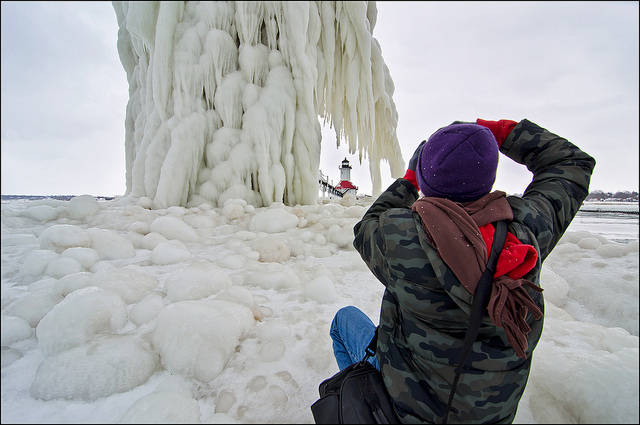
In one part of the country, Niagara Falls is freezing and the Northeast is expecting another onslaught of snow and record breaking temperatures this week, while the other part of the country, temperatures are also record breaking, but with extreme fire danger warnings due to the heat and winds. As I sit in 80 degree weather, in a sundress and flip flops, it’s difficult for me to fathom how cold -16 degrees actually is. A glimpse of the work from environmental and landscape photographer, Tom Gill, gives me a slight idea.
 Tom has spent the last several years braving the bitter cold and photographing lighthouses and bridges in Lake Michigan. After cold, windy days, he will drive the 90 miles from his home near Chicago in search of the piers and lighthouses that have been frozen over by high waves (some wave splashes as tall as 70ft!)
Tom has spent the last several years braving the bitter cold and photographing lighthouses and bridges in Lake Michigan. After cold, windy days, he will drive the 90 miles from his home near Chicago in search of the piers and lighthouses that have been frozen over by high waves (some wave splashes as tall as 70ft!)
[REWIND: Daredevil Shoots A Frozen City From Above | Images by Ronnie Yip]
I got the opportunity to chat with Tom about his images from the series, “Frozen World” and how he was able to capture them.

Being a California girl practically all my life, I cannot fathom how the pier freezes like that. Can you explain?
In the winter, when temperatures drop below freezing, the splashes and spray freeze onto the lighthouse tower, catwalk, and pier. Slowly, the ice builds up to what is shown in the photographs I’ve taken over the past several years. You can often see the change in wind direction by looking at the direction of the icicles hanging from the lighthouse. They frequently change direction, and freeze in zig-zag patterns. Interestingly enough, if the weather has been cold and relatively still, the surface of the lake will freeze, preventing waves from splashing onto the lighthouse, and a winter can go by without any ice build-up. This happened two winters ago.

What are some of the dangers when photographing frozen bridges and piers?
It is often very dangerous to walk out onto the pier after it’s covered in ice, yet sometimes the lake is not frozen solid, so one slip, and you could end up in 34 degree Fahrenheit water, with no way to climb out since everything is ice covered. If the water is frozen, the “shelf ice” and “drift ice” will often prevent you from resurfacing. Past that point, one must tread on a narrow, three or four foot wide walkway about 24 feet long leading around the lighthouse. This is often covered in ice, with no place to hold on to, and no railings. I always have second thoughts about the hike, but don’t really think about it until I’m back on shore. It’s certainly worth the walk out; it’s just not the same as seeing it from shore. My 14 year old son Chris often accompanies me on these trips, and has some great photos as well. Together, we walk out to the end of the pier to obtain views the other photographers miss.

What are some other dangers?
It’s very tempting to wander onto the huge mounds of ice along the shore of the lake. These shelf ice mounds can grow 15 feet tall, and stretch for miles along the shore, and hundreds of feet into the lake. They seem strong, yet due to the moving water beneath, faults, cracks and holes are often present, but snow covered. These defects in the ice provide a direct path to the freezing water below, where it’s next to impossible to climb out. I see dozens of people each winter running out to the end of the shelf ice for a better view, or an adventure, and I just can’t keep quiet about it, often calling out to them to explain how dangerous it is.

How do you protect your gear from such extreme weather conditions?
It’s quite a job to keep my gear dry, and sand-free, especially when it’s windy, or when I’m climbing dunes. I don’t generally use any types of enclosures on my camera or lenses, but keeping them in my bag when moving from place to place helps. I have, on occasion, cut a circle in the bottom of a large, clear ziplock bag, and stretched it over the threads of the front of the lens, encasing the camera in the bag, while keeping the front element exposed. It’s thin enough to control the camera, yet keeps the blowing sand and water off of the camera.



What else do you like to photograph, the rest of the year?
My work captures the natural and man made wonders of the southeastern portion of Lake Michigan, particularly lighthouses, the Indiana Dunes National Lakeshore (I have thousands of photos from the Indiana Dunes), barns, and small town nostalgia. My photographs have been featured internationally, in print, television, and the web. I hold a Fine Arts Degree in design from the University of Illinois at Chicago, and aside from photography, I enjoy woodworking, sketching, painting, and hiking with my family.
Where can we see more of your work?
Blog: https://lapstrake.blogspot.com
Flickr: https://www.flickr.com/photos/
CREDITS: All photographs shared by Tom Gill are copyrighted and have been used with permission for SLR Lounge. Do not copy, modify or re-post this article or images without express permission from SLR Lounge and the artist.




Get Connected!